Holmes Institute HI6008 Business Research Assignment 2 Lit Review
VerifiedAdded on 2023/01/20
|22
|7415
|73
Report
AI Summary
This report presents a comprehensive literature review on change management, focusing on its importance in ensuring business sustainability and competitiveness. It examines various change management theories, including Kotter's Eight-Step Approach and the McKinsey 7-S model, and explores factors driving organizational change, such as technology, globalization, and economic forces. The study delves into the need for effective change management strategies, the influence of leaders on employee attitudes, and methods to mitigate resistance to change. The research methodology encompasses research philosophy, strategy, data collection techniques, and analysis, with both qualitative and quantitative data sources. The findings of the study are summarized, followed by conclusions, limitations, and recommendations for successful change implementation within organizations.
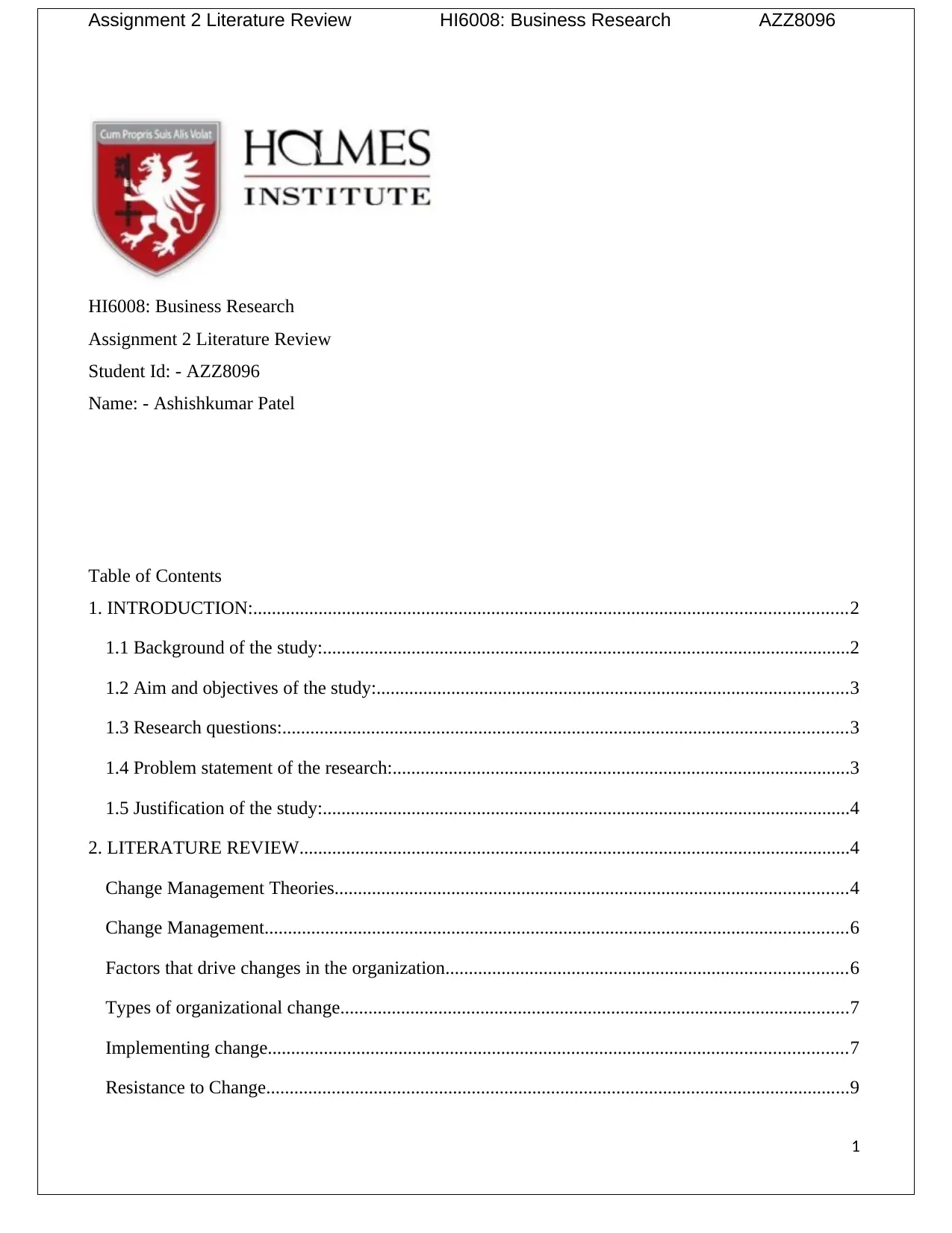
Assignment 2 Literature Review HI6008: Business Research AZZ8096
HI6008: Business Research
Assignment 2 Literature Review
Student Id: - AZZ8096
Name: - Ashishkumar Patel
Table of Contents
1. INTRODUCTION:...............................................................................................................................2
1.1 Background of the study:.................................................................................................................2
1.2 Aim and objectives of the study:.....................................................................................................3
1.3 Research questions:.........................................................................................................................3
1.4 Problem statement of the research:..................................................................................................3
1.5 Justification of the study:.................................................................................................................4
2. LITERATURE REVIEW......................................................................................................................4
Change Management Theories..............................................................................................................4
Change Management.............................................................................................................................6
Factors that drive changes in the organization......................................................................................6
Types of organizational change.............................................................................................................7
Implementing change............................................................................................................................7
Resistance to Change.............................................................................................................................9
1
HI6008: Business Research
Assignment 2 Literature Review
Student Id: - AZZ8096
Name: - Ashishkumar Patel
Table of Contents
1. INTRODUCTION:...............................................................................................................................2
1.1 Background of the study:.................................................................................................................2
1.2 Aim and objectives of the study:.....................................................................................................3
1.3 Research questions:.........................................................................................................................3
1.4 Problem statement of the research:..................................................................................................3
1.5 Justification of the study:.................................................................................................................4
2. LITERATURE REVIEW......................................................................................................................4
Change Management Theories..............................................................................................................4
Change Management.............................................................................................................................6
Factors that drive changes in the organization......................................................................................6
Types of organizational change.............................................................................................................7
Implementing change............................................................................................................................7
Resistance to Change.............................................................................................................................9
1
Paraphrase This Document
Need a fresh take? Get an instant paraphrase of this document with our AI Paraphraser
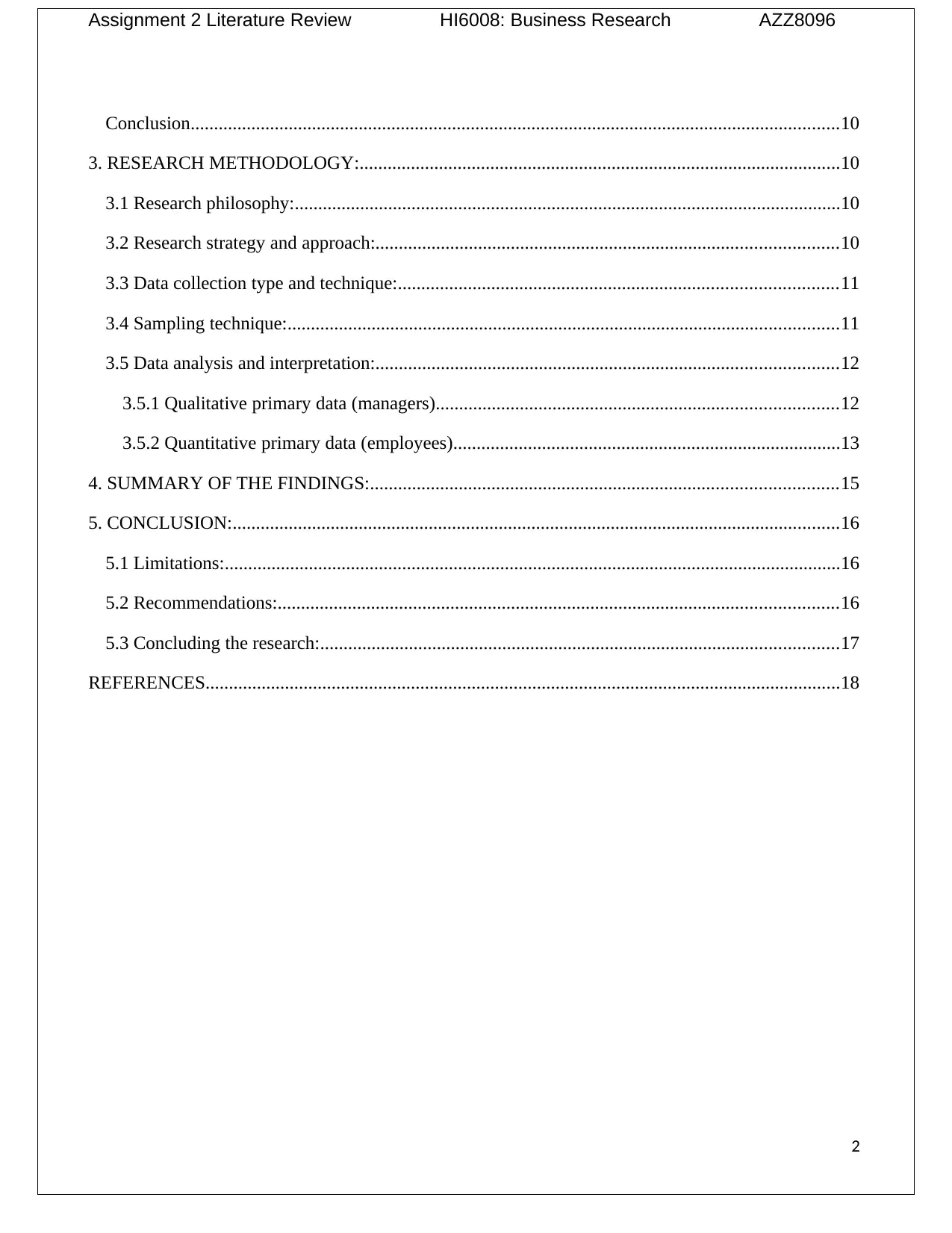
Assignment 2 Literature Review HI6008: Business Research AZZ8096
Conclusion...........................................................................................................................................10
3. RESEARCH METHODOLOGY:.......................................................................................................10
3.1 Research philosophy:.....................................................................................................................10
3.2 Research strategy and approach:...................................................................................................10
3.3 Data collection type and technique:..............................................................................................11
3.4 Sampling technique:......................................................................................................................11
3.5 Data analysis and interpretation:...................................................................................................12
3.5.1 Qualitative primary data (managers)......................................................................................12
3.5.2 Quantitative primary data (employees)...................................................................................13
4. SUMMARY OF THE FINDINGS:....................................................................................................15
5. CONCLUSION:..................................................................................................................................16
5.1 Limitations:....................................................................................................................................16
5.2 Recommendations:........................................................................................................................16
5.3 Concluding the research:...............................................................................................................17
REFERENCES........................................................................................................................................18
2
Conclusion...........................................................................................................................................10
3. RESEARCH METHODOLOGY:.......................................................................................................10
3.1 Research philosophy:.....................................................................................................................10
3.2 Research strategy and approach:...................................................................................................10
3.3 Data collection type and technique:..............................................................................................11
3.4 Sampling technique:......................................................................................................................11
3.5 Data analysis and interpretation:...................................................................................................12
3.5.1 Qualitative primary data (managers)......................................................................................12
3.5.2 Quantitative primary data (employees)...................................................................................13
4. SUMMARY OF THE FINDINGS:....................................................................................................15
5. CONCLUSION:..................................................................................................................................16
5.1 Limitations:....................................................................................................................................16
5.2 Recommendations:........................................................................................................................16
5.3 Concluding the research:...............................................................................................................17
REFERENCES........................................................................................................................................18
2
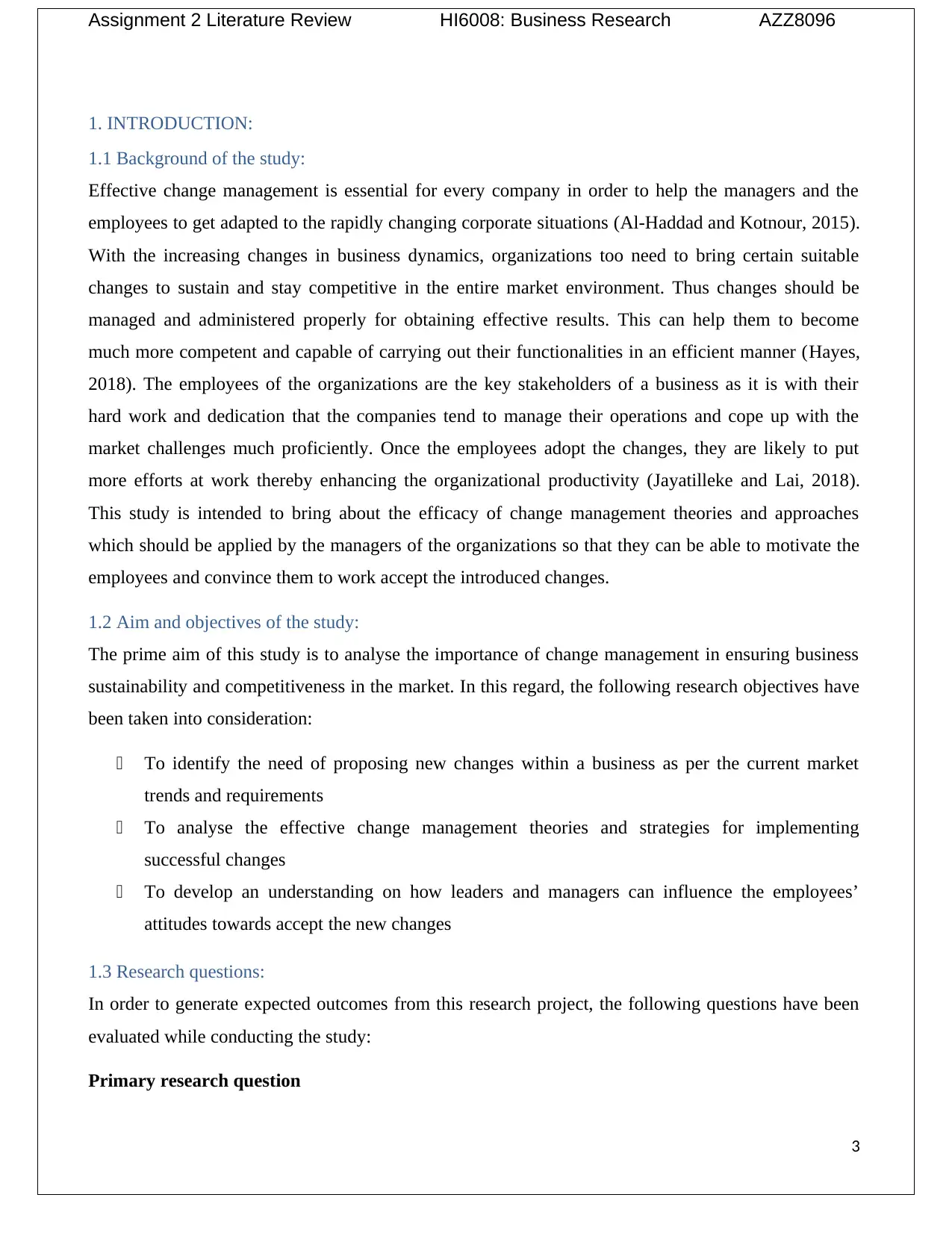
Assignment 2 Literature Review HI6008: Business Research AZZ8096
1. INTRODUCTION:
1.1 Background of the study:
Effective change management is essential for every company in order to help the managers and the
employees to get adapted to the rapidly changing corporate situations (Al-Haddad and Kotnour, 2015).
With the increasing changes in business dynamics, organizations too need to bring certain suitable
changes to sustain and stay competitive in the entire market environment. Thus changes should be
managed and administered properly for obtaining effective results. This can help them to become
much more competent and capable of carrying out their functionalities in an efficient manner (Hayes,
2018). The employees of the organizations are the key stakeholders of a business as it is with their
hard work and dedication that the companies tend to manage their operations and cope up with the
market challenges much proficiently. Once the employees adopt the changes, they are likely to put
more efforts at work thereby enhancing the organizational productivity (Jayatilleke and Lai, 2018).
This study is intended to bring about the efficacy of change management theories and approaches
which should be applied by the managers of the organizations so that they can be able to motivate the
employees and convince them to work accept the introduced changes.
1.2 Aim and objectives of the study:
The prime aim of this study is to analyse the importance of change management in ensuring business
sustainability and competitiveness in the market. In this regard, the following research objectives have
been taken into consideration:
To identify the need of proposing new changes within a business as per the current market
trends and requirements
To analyse the effective change management theories and strategies for implementing
successful changes
To develop an understanding on how leaders and managers can influence the employees’
attitudes towards accept the new changes
1.3 Research questions:
In order to generate expected outcomes from this research project, the following questions have been
evaluated while conducting the study:
Primary research question
3
1. INTRODUCTION:
1.1 Background of the study:
Effective change management is essential for every company in order to help the managers and the
employees to get adapted to the rapidly changing corporate situations (Al-Haddad and Kotnour, 2015).
With the increasing changes in business dynamics, organizations too need to bring certain suitable
changes to sustain and stay competitive in the entire market environment. Thus changes should be
managed and administered properly for obtaining effective results. This can help them to become
much more competent and capable of carrying out their functionalities in an efficient manner (Hayes,
2018). The employees of the organizations are the key stakeholders of a business as it is with their
hard work and dedication that the companies tend to manage their operations and cope up with the
market challenges much proficiently. Once the employees adopt the changes, they are likely to put
more efforts at work thereby enhancing the organizational productivity (Jayatilleke and Lai, 2018).
This study is intended to bring about the efficacy of change management theories and approaches
which should be applied by the managers of the organizations so that they can be able to motivate the
employees and convince them to work accept the introduced changes.
1.2 Aim and objectives of the study:
The prime aim of this study is to analyse the importance of change management in ensuring business
sustainability and competitiveness in the market. In this regard, the following research objectives have
been taken into consideration:
To identify the need of proposing new changes within a business as per the current market
trends and requirements
To analyse the effective change management theories and strategies for implementing
successful changes
To develop an understanding on how leaders and managers can influence the employees’
attitudes towards accept the new changes
1.3 Research questions:
In order to generate expected outcomes from this research project, the following questions have been
evaluated while conducting the study:
Primary research question
3
⊘ This is a preview!⊘
Do you want full access?
Subscribe today to unlock all pages.

Trusted by 1+ million students worldwide
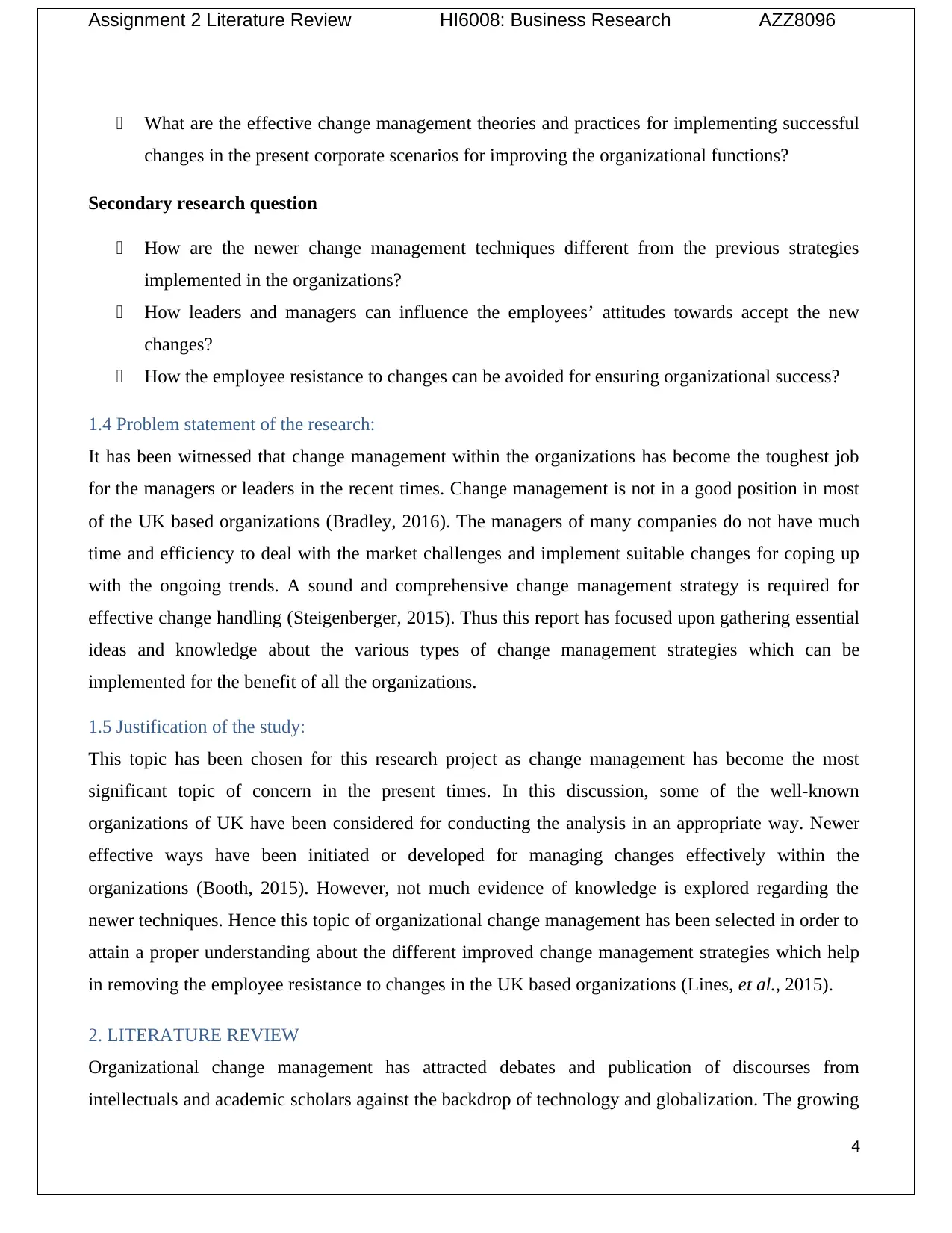
Assignment 2 Literature Review HI6008: Business Research AZZ8096
What are the effective change management theories and practices for implementing successful
changes in the present corporate scenarios for improving the organizational functions?
Secondary research question
How are the newer change management techniques different from the previous strategies
implemented in the organizations?
How leaders and managers can influence the employees’ attitudes towards accept the new
changes?
How the employee resistance to changes can be avoided for ensuring organizational success?
1.4 Problem statement of the research:
It has been witnessed that change management within the organizations has become the toughest job
for the managers or leaders in the recent times. Change management is not in a good position in most
of the UK based organizations (Bradley, 2016). The managers of many companies do not have much
time and efficiency to deal with the market challenges and implement suitable changes for coping up
with the ongoing trends. A sound and comprehensive change management strategy is required for
effective change handling (Steigenberger, 2015). Thus this report has focused upon gathering essential
ideas and knowledge about the various types of change management strategies which can be
implemented for the benefit of all the organizations.
1.5 Justification of the study:
This topic has been chosen for this research project as change management has become the most
significant topic of concern in the present times. In this discussion, some of the well-known
organizations of UK have been considered for conducting the analysis in an appropriate way. Newer
effective ways have been initiated or developed for managing changes effectively within the
organizations (Booth, 2015). However, not much evidence of knowledge is explored regarding the
newer techniques. Hence this topic of organizational change management has been selected in order to
attain a proper understanding about the different improved change management strategies which help
in removing the employee resistance to changes in the UK based organizations (Lines, et al., 2015).
2. LITERATURE REVIEW
Organizational change management has attracted debates and publication of discourses from
intellectuals and academic scholars against the backdrop of technology and globalization. The growing
4
What are the effective change management theories and practices for implementing successful
changes in the present corporate scenarios for improving the organizational functions?
Secondary research question
How are the newer change management techniques different from the previous strategies
implemented in the organizations?
How leaders and managers can influence the employees’ attitudes towards accept the new
changes?
How the employee resistance to changes can be avoided for ensuring organizational success?
1.4 Problem statement of the research:
It has been witnessed that change management within the organizations has become the toughest job
for the managers or leaders in the recent times. Change management is not in a good position in most
of the UK based organizations (Bradley, 2016). The managers of many companies do not have much
time and efficiency to deal with the market challenges and implement suitable changes for coping up
with the ongoing trends. A sound and comprehensive change management strategy is required for
effective change handling (Steigenberger, 2015). Thus this report has focused upon gathering essential
ideas and knowledge about the various types of change management strategies which can be
implemented for the benefit of all the organizations.
1.5 Justification of the study:
This topic has been chosen for this research project as change management has become the most
significant topic of concern in the present times. In this discussion, some of the well-known
organizations of UK have been considered for conducting the analysis in an appropriate way. Newer
effective ways have been initiated or developed for managing changes effectively within the
organizations (Booth, 2015). However, not much evidence of knowledge is explored regarding the
newer techniques. Hence this topic of organizational change management has been selected in order to
attain a proper understanding about the different improved change management strategies which help
in removing the employee resistance to changes in the UK based organizations (Lines, et al., 2015).
2. LITERATURE REVIEW
Organizational change management has attracted debates and publication of discourses from
intellectuals and academic scholars against the backdrop of technology and globalization. The growing
4
Paraphrase This Document
Need a fresh take? Get an instant paraphrase of this document with our AI Paraphraser
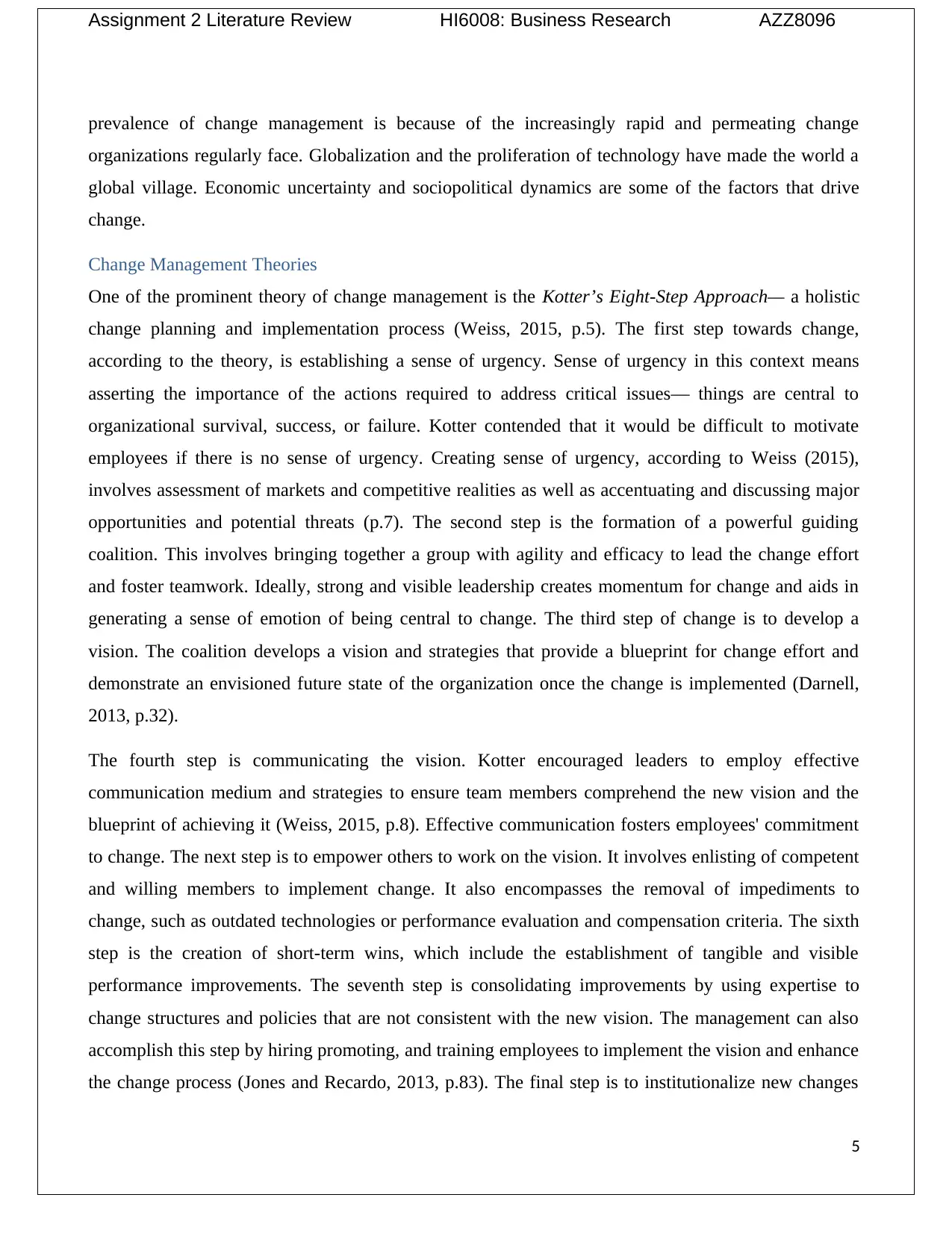
Assignment 2 Literature Review HI6008: Business Research AZZ8096
prevalence of change management is because of the increasingly rapid and permeating change
organizations regularly face. Globalization and the proliferation of technology have made the world a
global village. Economic uncertainty and sociopolitical dynamics are some of the factors that drive
change.
Change Management Theories
One of the prominent theory of change management is the Kotter’s Eight-Step Approach— a holistic
change planning and implementation process (Weiss, 2015, p.5). The first step towards change,
according to the theory, is establishing a sense of urgency. Sense of urgency in this context means
asserting the importance of the actions required to address critical issues— things are central to
organizational survival, success, or failure. Kotter contended that it would be difficult to motivate
employees if there is no sense of urgency. Creating sense of urgency, according to Weiss (2015),
involves assessment of markets and competitive realities as well as accentuating and discussing major
opportunities and potential threats (p.7). The second step is the formation of a powerful guiding
coalition. This involves bringing together a group with agility and efficacy to lead the change effort
and foster teamwork. Ideally, strong and visible leadership creates momentum for change and aids in
generating a sense of emotion of being central to change. The third step of change is to develop a
vision. The coalition develops a vision and strategies that provide a blueprint for change effort and
demonstrate an envisioned future state of the organization once the change is implemented (Darnell,
2013, p.32).
The fourth step is communicating the vision. Kotter encouraged leaders to employ effective
communication medium and strategies to ensure team members comprehend the new vision and the
blueprint of achieving it (Weiss, 2015, p.8). Effective communication fosters employees' commitment
to change. The next step is to empower others to work on the vision. It involves enlisting of competent
and willing members to implement change. It also encompasses the removal of impediments to
change, such as outdated technologies or performance evaluation and compensation criteria. The sixth
step is the creation of short-term wins, which include the establishment of tangible and visible
performance improvements. The seventh step is consolidating improvements by using expertise to
change structures and policies that are not consistent with the new vision. The management can also
accomplish this step by hiring promoting, and training employees to implement the vision and enhance
the change process (Jones and Recardo, 2013, p.83). The final step is to institutionalize new changes
5
prevalence of change management is because of the increasingly rapid and permeating change
organizations regularly face. Globalization and the proliferation of technology have made the world a
global village. Economic uncertainty and sociopolitical dynamics are some of the factors that drive
change.
Change Management Theories
One of the prominent theory of change management is the Kotter’s Eight-Step Approach— a holistic
change planning and implementation process (Weiss, 2015, p.5). The first step towards change,
according to the theory, is establishing a sense of urgency. Sense of urgency in this context means
asserting the importance of the actions required to address critical issues— things are central to
organizational survival, success, or failure. Kotter contended that it would be difficult to motivate
employees if there is no sense of urgency. Creating sense of urgency, according to Weiss (2015),
involves assessment of markets and competitive realities as well as accentuating and discussing major
opportunities and potential threats (p.7). The second step is the formation of a powerful guiding
coalition. This involves bringing together a group with agility and efficacy to lead the change effort
and foster teamwork. Ideally, strong and visible leadership creates momentum for change and aids in
generating a sense of emotion of being central to change. The third step of change is to develop a
vision. The coalition develops a vision and strategies that provide a blueprint for change effort and
demonstrate an envisioned future state of the organization once the change is implemented (Darnell,
2013, p.32).
The fourth step is communicating the vision. Kotter encouraged leaders to employ effective
communication medium and strategies to ensure team members comprehend the new vision and the
blueprint of achieving it (Weiss, 2015, p.8). Effective communication fosters employees' commitment
to change. The next step is to empower others to work on the vision. It involves enlisting of competent
and willing members to implement change. It also encompasses the removal of impediments to
change, such as outdated technologies or performance evaluation and compensation criteria. The sixth
step is the creation of short-term wins, which include the establishment of tangible and visible
performance improvements. The seventh step is consolidating improvements by using expertise to
change structures and policies that are not consistent with the new vision. The management can also
accomplish this step by hiring promoting, and training employees to implement the vision and enhance
the change process (Jones and Recardo, 2013, p.83). The final step is to institutionalize new changes
5

Assignment 2 Literature Review HI6008: Business Research AZZ8096
into the organizational culture. It involves making the change as an integral part of the corporate
culture.
Another theory that supports change management is The McKinsey 7-S model. The model was
developed in the 1980s by Robert H. Waterman, Jr. and Tom Peters to provide a roadmap to
companies in, assessing, analyzing, and monitoring change in the organization (Hayes, 2014, p..123).
The 7-Ss, which the model sits on, are structure, strategy, systems, staff, skills, style, and shared
values. The first three are known as hard elements since they are easy to identify and define, and
management can directly influence them; examples, IT systems, strategy statements, and formal
processes. The last four are categorized as soft elements because they are difficult to define and are
often influenced by culture. Strategy refers to the plan designed to build a competitive advantage in
pursuit of sustaining competition. Starbucks business strategy is entrenched on product differentiation
with a focus on the quality of product and services (Dudovskiy, 2017, par1). Massive integration of
technology with various business processes, particularly in the ordering process represents a vital hue
of Starbuck business strategy, for example. When assessing the strategy of a company, there is a need
to consider the objectives and flexibility of the company in accommodating the change. The company's
structure— in terms of hierarchy, communication, and decision-making— should be simple to enhance
the effectiveness of change. For instance, Starbucks has a divisional organizational structure, which
integrates brand-based and geographical divisions (Dudovskiy, 2017, par2). On systems, the
organization should ensure that core systems— document management, finance, and HR— are
accurate, updated, and accessible to support change. In terms of values, the management should
analyze the corporate culture and core values, and identify strong values that inhere change. Starbucks,
for example, emphasizes on "Starbucks experience," which includes friendly staff, coffee, and
comfortable meeting place (Dudovskiy, 2017, par4). The style involves analysis of leadership
approach in the organization in terms of effectiveness, cooperation, and participation. The organization
style of Starbucks is defined as flexible, innovative, and team-oriented. Assessing staff comprises
analysis of specialization needed, gaps to be filled, and gaps that demand competencies. Finally, the
organization should analyze strongest skills and skill gaps in change management.
Change Management
The concept of change management has been explored and documented by the existing literature.
Change management refers to the processes and approaches adopted by business content to facilitating
6
into the organizational culture. It involves making the change as an integral part of the corporate
culture.
Another theory that supports change management is The McKinsey 7-S model. The model was
developed in the 1980s by Robert H. Waterman, Jr. and Tom Peters to provide a roadmap to
companies in, assessing, analyzing, and monitoring change in the organization (Hayes, 2014, p..123).
The 7-Ss, which the model sits on, are structure, strategy, systems, staff, skills, style, and shared
values. The first three are known as hard elements since they are easy to identify and define, and
management can directly influence them; examples, IT systems, strategy statements, and formal
processes. The last four are categorized as soft elements because they are difficult to define and are
often influenced by culture. Strategy refers to the plan designed to build a competitive advantage in
pursuit of sustaining competition. Starbucks business strategy is entrenched on product differentiation
with a focus on the quality of product and services (Dudovskiy, 2017, par1). Massive integration of
technology with various business processes, particularly in the ordering process represents a vital hue
of Starbuck business strategy, for example. When assessing the strategy of a company, there is a need
to consider the objectives and flexibility of the company in accommodating the change. The company's
structure— in terms of hierarchy, communication, and decision-making— should be simple to enhance
the effectiveness of change. For instance, Starbucks has a divisional organizational structure, which
integrates brand-based and geographical divisions (Dudovskiy, 2017, par2). On systems, the
organization should ensure that core systems— document management, finance, and HR— are
accurate, updated, and accessible to support change. In terms of values, the management should
analyze the corporate culture and core values, and identify strong values that inhere change. Starbucks,
for example, emphasizes on "Starbucks experience," which includes friendly staff, coffee, and
comfortable meeting place (Dudovskiy, 2017, par4). The style involves analysis of leadership
approach in the organization in terms of effectiveness, cooperation, and participation. The organization
style of Starbucks is defined as flexible, innovative, and team-oriented. Assessing staff comprises
analysis of specialization needed, gaps to be filled, and gaps that demand competencies. Finally, the
organization should analyze strongest skills and skill gaps in change management.
Change Management
The concept of change management has been explored and documented by the existing literature.
Change management refers to the processes and approaches adopted by business content to facilitating
6
⊘ This is a preview!⊘
Do you want full access?
Subscribe today to unlock all pages.

Trusted by 1+ million students worldwide

Assignment 2 Literature Review HI6008: Business Research AZZ8096
the leaders in moving units or entire organization from the present to the desired state. Change
management is underpinned on content-based disciplines of strategic operations, business,
management, and finance. Some of the areas that demand change management include financial
analysis— design-solutions, inventory control, and workflow analysis; marketing planning, project
management, strategic planning, and IT infrastructure support (Pollack, 2016). Ideally, the main aim of
change management is to align business objectives with new systems and strategies. Change
management consultants usually specialize on a particular content field such as manufacturing,
strategy, IT, marketing, or operations (Weiss, 2015, p.14).
Factors that drive changes in the organization
Scholars have explored internal and external factors that trigger changes in the organization.
According to Cameron and Green (2015), the main internal factors that could drive organizational
change are unforeseen opportunities for business growth, change in managerial personnel, and change
in operative personnel, organizational culture, leadership, organizational strategy (p.114). A new
manager or operators may bring new ideas into the organization, which necessitate change.
Organizational culture is comprised of an interlocking set of roles, goals, values, practices,
communication, and attitudes. When these elements are combined, they can influence or impede
change in an organization.
Abudi (2017) documented macro or external factors that drive change in the organization—
technological forces, environmental forces, economic, socio-cultural forces, and political-legal forces
(p.33). Technology drives innovation and change. In practice, organizations optimize information
technologies to develop strategies and systems that enhance speed, effectiveness, and efficiency in
reaching stakeholders and customers around the globe. Resource supplies and prices put pressure on
business growth, which is influenced by taxes and government regulations on the emission of carbon.
Besides, consumers anticipate companies to adopt production practices that are sustainable to the
environment. Companies are therefore compelled to incorporate green logic into change management
strategy. Based on economic forces globalization, cost of labor, and market conditions are key drivers
of change in the organization (Cameron and Green, 2015, p.52). In terms of social-cultural forces,
work-family and work-life issues are the major drivers of workforce change. Cawsey et al. (2015)
argue that not all organizations should or will react to external forces of change, or in the same manner
7
the leaders in moving units or entire organization from the present to the desired state. Change
management is underpinned on content-based disciplines of strategic operations, business,
management, and finance. Some of the areas that demand change management include financial
analysis— design-solutions, inventory control, and workflow analysis; marketing planning, project
management, strategic planning, and IT infrastructure support (Pollack, 2016). Ideally, the main aim of
change management is to align business objectives with new systems and strategies. Change
management consultants usually specialize on a particular content field such as manufacturing,
strategy, IT, marketing, or operations (Weiss, 2015, p.14).
Factors that drive changes in the organization
Scholars have explored internal and external factors that trigger changes in the organization.
According to Cameron and Green (2015), the main internal factors that could drive organizational
change are unforeseen opportunities for business growth, change in managerial personnel, and change
in operative personnel, organizational culture, leadership, organizational strategy (p.114). A new
manager or operators may bring new ideas into the organization, which necessitate change.
Organizational culture is comprised of an interlocking set of roles, goals, values, practices,
communication, and attitudes. When these elements are combined, they can influence or impede
change in an organization.
Abudi (2017) documented macro or external factors that drive change in the organization—
technological forces, environmental forces, economic, socio-cultural forces, and political-legal forces
(p.33). Technology drives innovation and change. In practice, organizations optimize information
technologies to develop strategies and systems that enhance speed, effectiveness, and efficiency in
reaching stakeholders and customers around the globe. Resource supplies and prices put pressure on
business growth, which is influenced by taxes and government regulations on the emission of carbon.
Besides, consumers anticipate companies to adopt production practices that are sustainable to the
environment. Companies are therefore compelled to incorporate green logic into change management
strategy. Based on economic forces globalization, cost of labor, and market conditions are key drivers
of change in the organization (Cameron and Green, 2015, p.52). In terms of social-cultural forces,
work-family and work-life issues are the major drivers of workforce change. Cawsey et al. (2015)
argue that not all organizations should or will react to external forces of change, or in the same manner
7
Paraphrase This Document
Need a fresh take? Get an instant paraphrase of this document with our AI Paraphraser
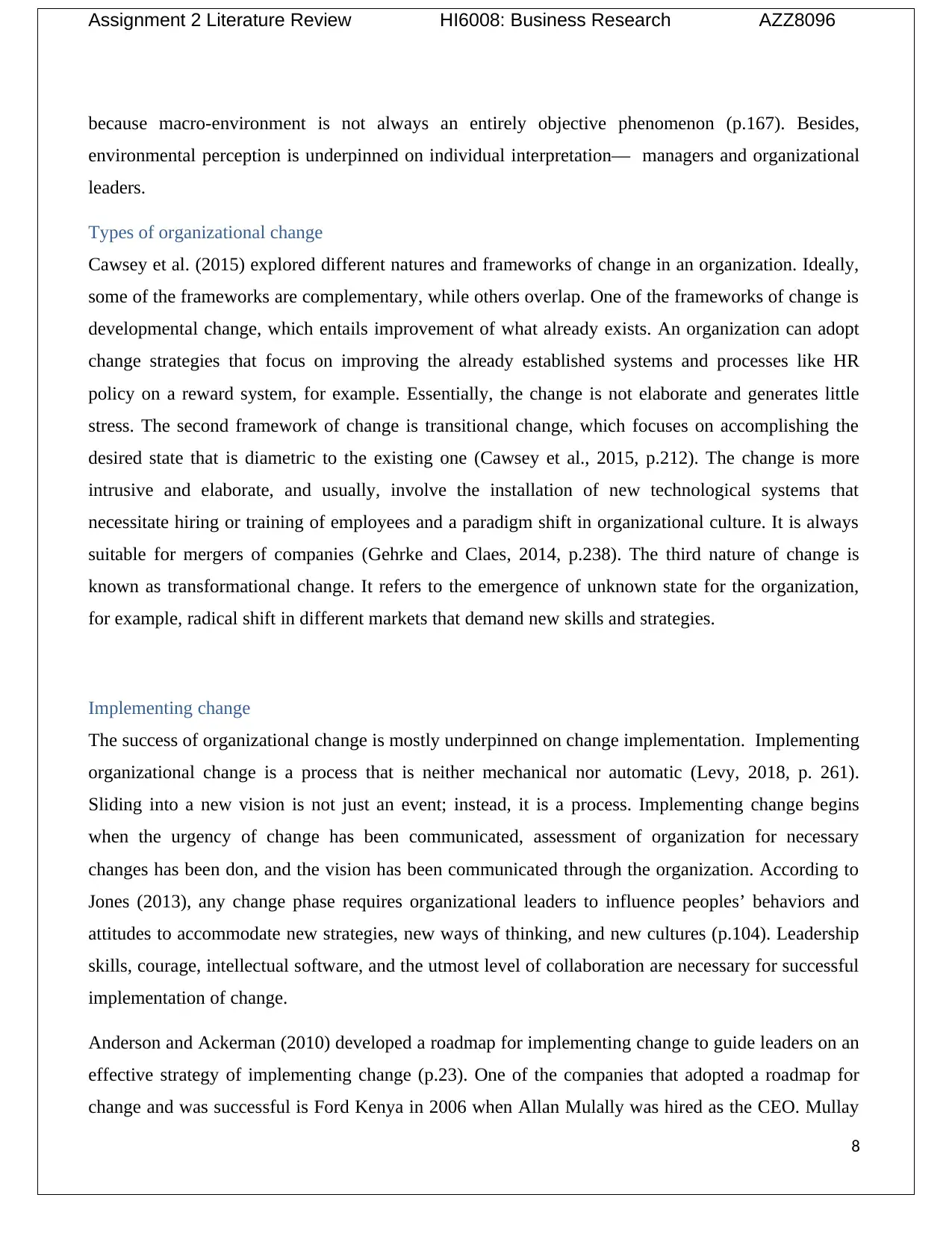
Assignment 2 Literature Review HI6008: Business Research AZZ8096
because macro-environment is not always an entirely objective phenomenon (p.167). Besides,
environmental perception is underpinned on individual interpretation— managers and organizational
leaders.
Types of organizational change
Cawsey et al. (2015) explored different natures and frameworks of change in an organization. Ideally,
some of the frameworks are complementary, while others overlap. One of the frameworks of change is
developmental change, which entails improvement of what already exists. An organization can adopt
change strategies that focus on improving the already established systems and processes like HR
policy on a reward system, for example. Essentially, the change is not elaborate and generates little
stress. The second framework of change is transitional change, which focuses on accomplishing the
desired state that is diametric to the existing one (Cawsey et al., 2015, p.212). The change is more
intrusive and elaborate, and usually, involve the installation of new technological systems that
necessitate hiring or training of employees and a paradigm shift in organizational culture. It is always
suitable for mergers of companies (Gehrke and Claes, 2014, p.238). The third nature of change is
known as transformational change. It refers to the emergence of unknown state for the organization,
for example, radical shift in different markets that demand new skills and strategies.
Implementing change
The success of organizational change is mostly underpinned on change implementation. Implementing
organizational change is a process that is neither mechanical nor automatic (Levy, 2018, p. 261).
Sliding into a new vision is not just an event; instead, it is a process. Implementing change begins
when the urgency of change has been communicated, assessment of organization for necessary
changes has been don, and the vision has been communicated through the organization. According to
Jones (2013), any change phase requires organizational leaders to influence peoples’ behaviors and
attitudes to accommodate new strategies, new ways of thinking, and new cultures (p.104). Leadership
skills, courage, intellectual software, and the utmost level of collaboration are necessary for successful
implementation of change.
Anderson and Ackerman (2010) developed a roadmap for implementing change to guide leaders on an
effective strategy of implementing change (p.23). One of the companies that adopted a roadmap for
change and was successful is Ford Kenya in 2006 when Allan Mulally was hired as the CEO. Mullay
8
because macro-environment is not always an entirely objective phenomenon (p.167). Besides,
environmental perception is underpinned on individual interpretation— managers and organizational
leaders.
Types of organizational change
Cawsey et al. (2015) explored different natures and frameworks of change in an organization. Ideally,
some of the frameworks are complementary, while others overlap. One of the frameworks of change is
developmental change, which entails improvement of what already exists. An organization can adopt
change strategies that focus on improving the already established systems and processes like HR
policy on a reward system, for example. Essentially, the change is not elaborate and generates little
stress. The second framework of change is transitional change, which focuses on accomplishing the
desired state that is diametric to the existing one (Cawsey et al., 2015, p.212). The change is more
intrusive and elaborate, and usually, involve the installation of new technological systems that
necessitate hiring or training of employees and a paradigm shift in organizational culture. It is always
suitable for mergers of companies (Gehrke and Claes, 2014, p.238). The third nature of change is
known as transformational change. It refers to the emergence of unknown state for the organization,
for example, radical shift in different markets that demand new skills and strategies.
Implementing change
The success of organizational change is mostly underpinned on change implementation. Implementing
organizational change is a process that is neither mechanical nor automatic (Levy, 2018, p. 261).
Sliding into a new vision is not just an event; instead, it is a process. Implementing change begins
when the urgency of change has been communicated, assessment of organization for necessary
changes has been don, and the vision has been communicated through the organization. According to
Jones (2013), any change phase requires organizational leaders to influence peoples’ behaviors and
attitudes to accommodate new strategies, new ways of thinking, and new cultures (p.104). Leadership
skills, courage, intellectual software, and the utmost level of collaboration are necessary for successful
implementation of change.
Anderson and Ackerman (2010) developed a roadmap for implementing change to guide leaders on an
effective strategy of implementing change (p.23). One of the companies that adopted a roadmap for
change and was successful is Ford Kenya in 2006 when Allan Mulally was hired as the CEO. Mullay
8

Assignment 2 Literature Review HI6008: Business Research AZZ8096
developed a Way Forward Plan, which “centralized and modernized plants to handle several models at
once, to be sold in several Markets” (Weiss, 2015, p.104). The first stage of the road map is preparing
to lead the change, which involves learning the reality on the ground by studying facts and detail and
then lodging claim for change by highlighting the desired outcome. When Mullay was appointed the
CEO of Ford, he prepared for change for by building capacity to lead change and ensuring employees
have relevant skill sets (Weiss, 2015, p.109). The second stage is developing a vision, commitment,
and capability. The CEO can accomplish this by reorienting functional managers and top-level global
officers to the long-term goals of the company and operating objectives. Mullay's ultimate vision was
to reposition in its previous status in the global auto industry. He expressed his strong commitment for
change when he said he “expects the very best of himself and others, [and] seeks to understand rather
than to be understood” (Weiss, 2015, p.109). He built formidable capability by reorienting 12
functional managers top-level global officers to the company’s short-term objectives and long-term
goals. The third stage is assessing the situation by using changing data to analyze the vision's impact
and company goals. Mullay assessed Ford's financial position, marketing status, sales, and capabilities
against the backdrop of global competition. Finally, the leadership of the organization can plan,
organize, and implement change. Mullay’s plan was anchored on implementation of his “One Team,
One Plan, One Goal” mantra (Weiss, 2015, p.110). He met with Ford Chair, managers, and other
employees to plan for change. Mullay emphasized open communication and transparency. Coupled
with his confidence, intuition, and discipline, he successfully implanted the roadmap and implemented
the change, which paved way for Ford’s current success.
Abudi (2017) contributed immensely on change management building dimensions of leading and
managing change on a five-legged stool that sits on motivation, creating a vision, managing transition,
developing political support, and sustaining the momentum (p.161). Leaders can motivate the change
process by adopting effective communication of the new visions and the planning on how to mitigate
change resistance. Since the change process is quintessentially dynamic, it is imperative that the
change process is aligned with organizational vision and values (Hornstein, 2015, p.295; Gigliotti et
al., 2018, p.89). Leaders should be cognizant of the fact that changing one part of the organization may
have a significant impact on other areas. For instance, introducing structural change may change the
organizational culture. Internal politics are vital for change implementation, and therefore, leaders
should identify influential and key stakeholders to facilitate the implementation process. Leaders can
also develop political support by using social networks to leverage change and overcome change
9
developed a Way Forward Plan, which “centralized and modernized plants to handle several models at
once, to be sold in several Markets” (Weiss, 2015, p.104). The first stage of the road map is preparing
to lead the change, which involves learning the reality on the ground by studying facts and detail and
then lodging claim for change by highlighting the desired outcome. When Mullay was appointed the
CEO of Ford, he prepared for change for by building capacity to lead change and ensuring employees
have relevant skill sets (Weiss, 2015, p.109). The second stage is developing a vision, commitment,
and capability. The CEO can accomplish this by reorienting functional managers and top-level global
officers to the long-term goals of the company and operating objectives. Mullay's ultimate vision was
to reposition in its previous status in the global auto industry. He expressed his strong commitment for
change when he said he “expects the very best of himself and others, [and] seeks to understand rather
than to be understood” (Weiss, 2015, p.109). He built formidable capability by reorienting 12
functional managers top-level global officers to the company’s short-term objectives and long-term
goals. The third stage is assessing the situation by using changing data to analyze the vision's impact
and company goals. Mullay assessed Ford's financial position, marketing status, sales, and capabilities
against the backdrop of global competition. Finally, the leadership of the organization can plan,
organize, and implement change. Mullay’s plan was anchored on implementation of his “One Team,
One Plan, One Goal” mantra (Weiss, 2015, p.110). He met with Ford Chair, managers, and other
employees to plan for change. Mullay emphasized open communication and transparency. Coupled
with his confidence, intuition, and discipline, he successfully implanted the roadmap and implemented
the change, which paved way for Ford’s current success.
Abudi (2017) contributed immensely on change management building dimensions of leading and
managing change on a five-legged stool that sits on motivation, creating a vision, managing transition,
developing political support, and sustaining the momentum (p.161). Leaders can motivate the change
process by adopting effective communication of the new visions and the planning on how to mitigate
change resistance. Since the change process is quintessentially dynamic, it is imperative that the
change process is aligned with organizational vision and values (Hornstein, 2015, p.295; Gigliotti et
al., 2018, p.89). Leaders should be cognizant of the fact that changing one part of the organization may
have a significant impact on other areas. For instance, introducing structural change may change the
organizational culture. Internal politics are vital for change implementation, and therefore, leaders
should identify influential and key stakeholders to facilitate the implementation process. Leaders can
also develop political support by using social networks to leverage change and overcome change
9
⊘ This is a preview!⊘
Do you want full access?
Subscribe today to unlock all pages.

Trusted by 1+ million students worldwide
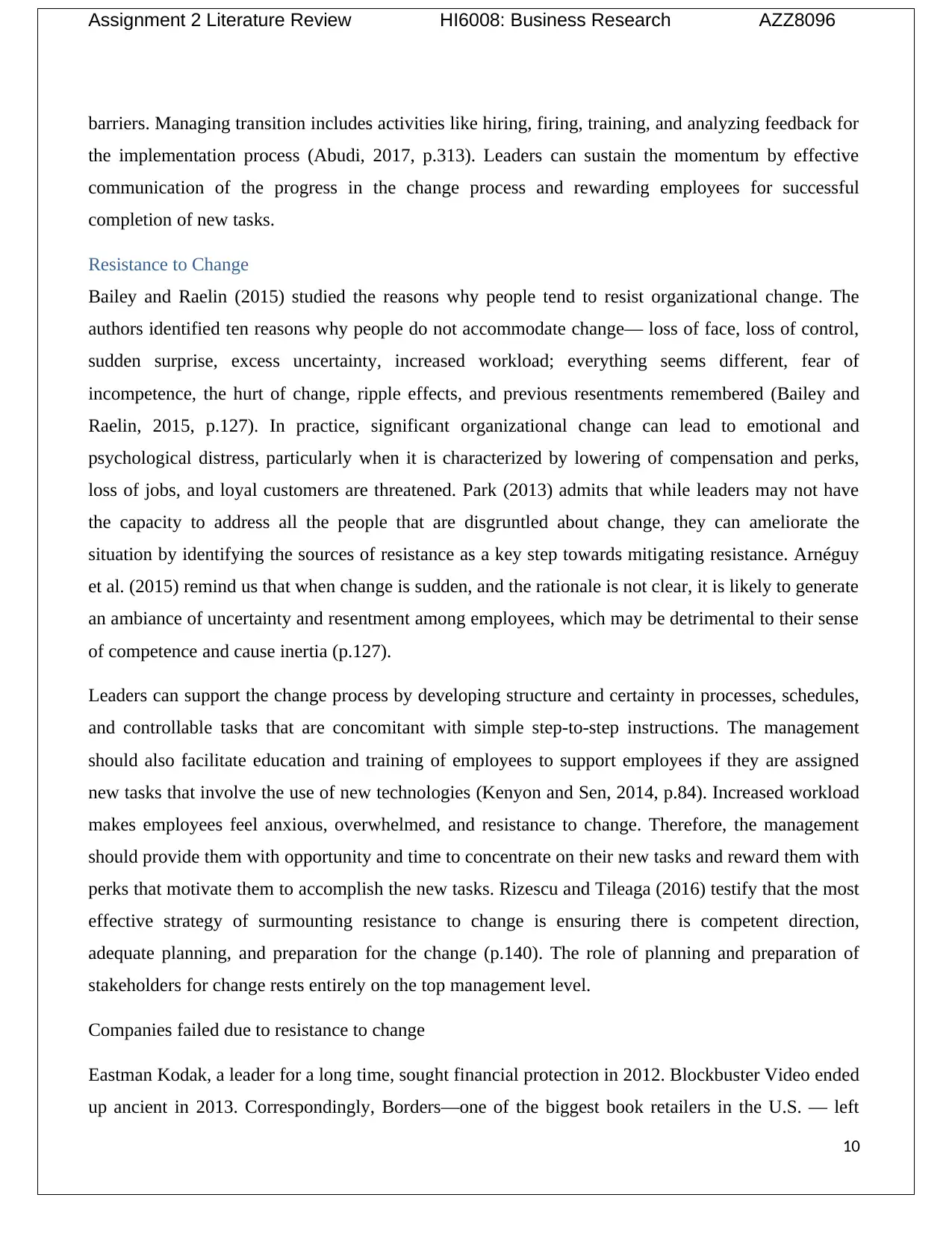
Assignment 2 Literature Review HI6008: Business Research AZZ8096
barriers. Managing transition includes activities like hiring, firing, training, and analyzing feedback for
the implementation process (Abudi, 2017, p.313). Leaders can sustain the momentum by effective
communication of the progress in the change process and rewarding employees for successful
completion of new tasks.
Resistance to Change
Bailey and Raelin (2015) studied the reasons why people tend to resist organizational change. The
authors identified ten reasons why people do not accommodate change— loss of face, loss of control,
sudden surprise, excess uncertainty, increased workload; everything seems different, fear of
incompetence, the hurt of change, ripple effects, and previous resentments remembered (Bailey and
Raelin, 2015, p.127). In practice, significant organizational change can lead to emotional and
psychological distress, particularly when it is characterized by lowering of compensation and perks,
loss of jobs, and loyal customers are threatened. Park (2013) admits that while leaders may not have
the capacity to address all the people that are disgruntled about change, they can ameliorate the
situation by identifying the sources of resistance as a key step towards mitigating resistance. Arnéguy
et al. (2015) remind us that when change is sudden, and the rationale is not clear, it is likely to generate
an ambiance of uncertainty and resentment among employees, which may be detrimental to their sense
of competence and cause inertia (p.127).
Leaders can support the change process by developing structure and certainty in processes, schedules,
and controllable tasks that are concomitant with simple step-to-step instructions. The management
should also facilitate education and training of employees to support employees if they are assigned
new tasks that involve the use of new technologies (Kenyon and Sen, 2014, p.84). Increased workload
makes employees feel anxious, overwhelmed, and resistance to change. Therefore, the management
should provide them with opportunity and time to concentrate on their new tasks and reward them with
perks that motivate them to accomplish the new tasks. Rizescu and Tileaga (2016) testify that the most
effective strategy of surmounting resistance to change is ensuring there is competent direction,
adequate planning, and preparation for the change (p.140). The role of planning and preparation of
stakeholders for change rests entirely on the top management level.
Companies failed due to resistance to change
Eastman Kodak, a leader for a long time, sought financial protection in 2012. Blockbuster Video ended
up ancient in 2013. Correspondingly, Borders—one of the biggest book retailers in the U.S. — left
10
barriers. Managing transition includes activities like hiring, firing, training, and analyzing feedback for
the implementation process (Abudi, 2017, p.313). Leaders can sustain the momentum by effective
communication of the progress in the change process and rewarding employees for successful
completion of new tasks.
Resistance to Change
Bailey and Raelin (2015) studied the reasons why people tend to resist organizational change. The
authors identified ten reasons why people do not accommodate change— loss of face, loss of control,
sudden surprise, excess uncertainty, increased workload; everything seems different, fear of
incompetence, the hurt of change, ripple effects, and previous resentments remembered (Bailey and
Raelin, 2015, p.127). In practice, significant organizational change can lead to emotional and
psychological distress, particularly when it is characterized by lowering of compensation and perks,
loss of jobs, and loyal customers are threatened. Park (2013) admits that while leaders may not have
the capacity to address all the people that are disgruntled about change, they can ameliorate the
situation by identifying the sources of resistance as a key step towards mitigating resistance. Arnéguy
et al. (2015) remind us that when change is sudden, and the rationale is not clear, it is likely to generate
an ambiance of uncertainty and resentment among employees, which may be detrimental to their sense
of competence and cause inertia (p.127).
Leaders can support the change process by developing structure and certainty in processes, schedules,
and controllable tasks that are concomitant with simple step-to-step instructions. The management
should also facilitate education and training of employees to support employees if they are assigned
new tasks that involve the use of new technologies (Kenyon and Sen, 2014, p.84). Increased workload
makes employees feel anxious, overwhelmed, and resistance to change. Therefore, the management
should provide them with opportunity and time to concentrate on their new tasks and reward them with
perks that motivate them to accomplish the new tasks. Rizescu and Tileaga (2016) testify that the most
effective strategy of surmounting resistance to change is ensuring there is competent direction,
adequate planning, and preparation for the change (p.140). The role of planning and preparation of
stakeholders for change rests entirely on the top management level.
Companies failed due to resistance to change
Eastman Kodak, a leader for a long time, sought financial protection in 2012. Blockbuster Video ended
up ancient in 2013. Correspondingly, Borders—one of the biggest book retailers in the U.S. — left
10
Paraphrase This Document
Need a fresh take? Get an instant paraphrase of this document with our AI Paraphraser
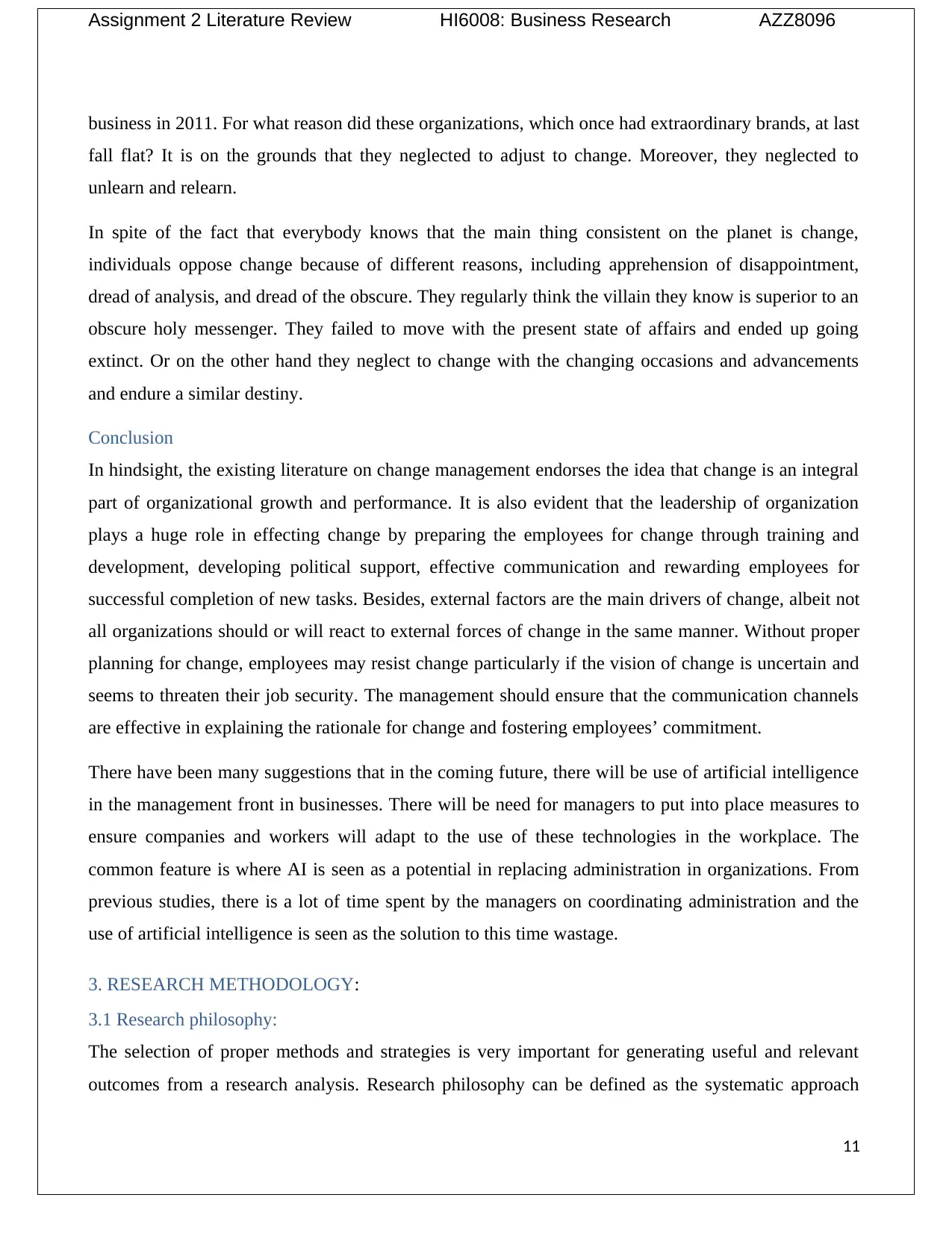
Assignment 2 Literature Review HI6008: Business Research AZZ8096
business in 2011. For what reason did these organizations, which once had extraordinary brands, at last
fall flat? It is on the grounds that they neglected to adjust to change. Moreover, they neglected to
unlearn and relearn.
In spite of the fact that everybody knows that the main thing consistent on the planet is change,
individuals oppose change because of different reasons, including apprehension of disappointment,
dread of analysis, and dread of the obscure. They regularly think the villain they know is superior to an
obscure holy messenger. They failed to move with the present state of affairs and ended up going
extinct. Or on the other hand they neglect to change with the changing occasions and advancements
and endure a similar destiny.
Conclusion
In hindsight, the existing literature on change management endorses the idea that change is an integral
part of organizational growth and performance. It is also evident that the leadership of organization
plays a huge role in effecting change by preparing the employees for change through training and
development, developing political support, effective communication and rewarding employees for
successful completion of new tasks. Besides, external factors are the main drivers of change, albeit not
all organizations should or will react to external forces of change in the same manner. Without proper
planning for change, employees may resist change particularly if the vision of change is uncertain and
seems to threaten their job security. The management should ensure that the communication channels
are effective in explaining the rationale for change and fostering employees’ commitment.
There have been many suggestions that in the coming future, there will be use of artificial intelligence
in the management front in businesses. There will be need for managers to put into place measures to
ensure companies and workers will adapt to the use of these technologies in the workplace. The
common feature is where AI is seen as a potential in replacing administration in organizations. From
previous studies, there is a lot of time spent by the managers on coordinating administration and the
use of artificial intelligence is seen as the solution to this time wastage.
3. RESEARCH METHODOLOGY:
3.1 Research philosophy:
The selection of proper methods and strategies is very important for generating useful and relevant
outcomes from a research analysis. Research philosophy can be defined as the systematic approach
11
business in 2011. For what reason did these organizations, which once had extraordinary brands, at last
fall flat? It is on the grounds that they neglected to adjust to change. Moreover, they neglected to
unlearn and relearn.
In spite of the fact that everybody knows that the main thing consistent on the planet is change,
individuals oppose change because of different reasons, including apprehension of disappointment,
dread of analysis, and dread of the obscure. They regularly think the villain they know is superior to an
obscure holy messenger. They failed to move with the present state of affairs and ended up going
extinct. Or on the other hand they neglect to change with the changing occasions and advancements
and endure a similar destiny.
Conclusion
In hindsight, the existing literature on change management endorses the idea that change is an integral
part of organizational growth and performance. It is also evident that the leadership of organization
plays a huge role in effecting change by preparing the employees for change through training and
development, developing political support, effective communication and rewarding employees for
successful completion of new tasks. Besides, external factors are the main drivers of change, albeit not
all organizations should or will react to external forces of change in the same manner. Without proper
planning for change, employees may resist change particularly if the vision of change is uncertain and
seems to threaten their job security. The management should ensure that the communication channels
are effective in explaining the rationale for change and fostering employees’ commitment.
There have been many suggestions that in the coming future, there will be use of artificial intelligence
in the management front in businesses. There will be need for managers to put into place measures to
ensure companies and workers will adapt to the use of these technologies in the workplace. The
common feature is where AI is seen as a potential in replacing administration in organizations. From
previous studies, there is a lot of time spent by the managers on coordinating administration and the
use of artificial intelligence is seen as the solution to this time wastage.
3. RESEARCH METHODOLOGY:
3.1 Research philosophy:
The selection of proper methods and strategies is very important for generating useful and relevant
outcomes from a research analysis. Research philosophy can be defined as the systematic approach
11
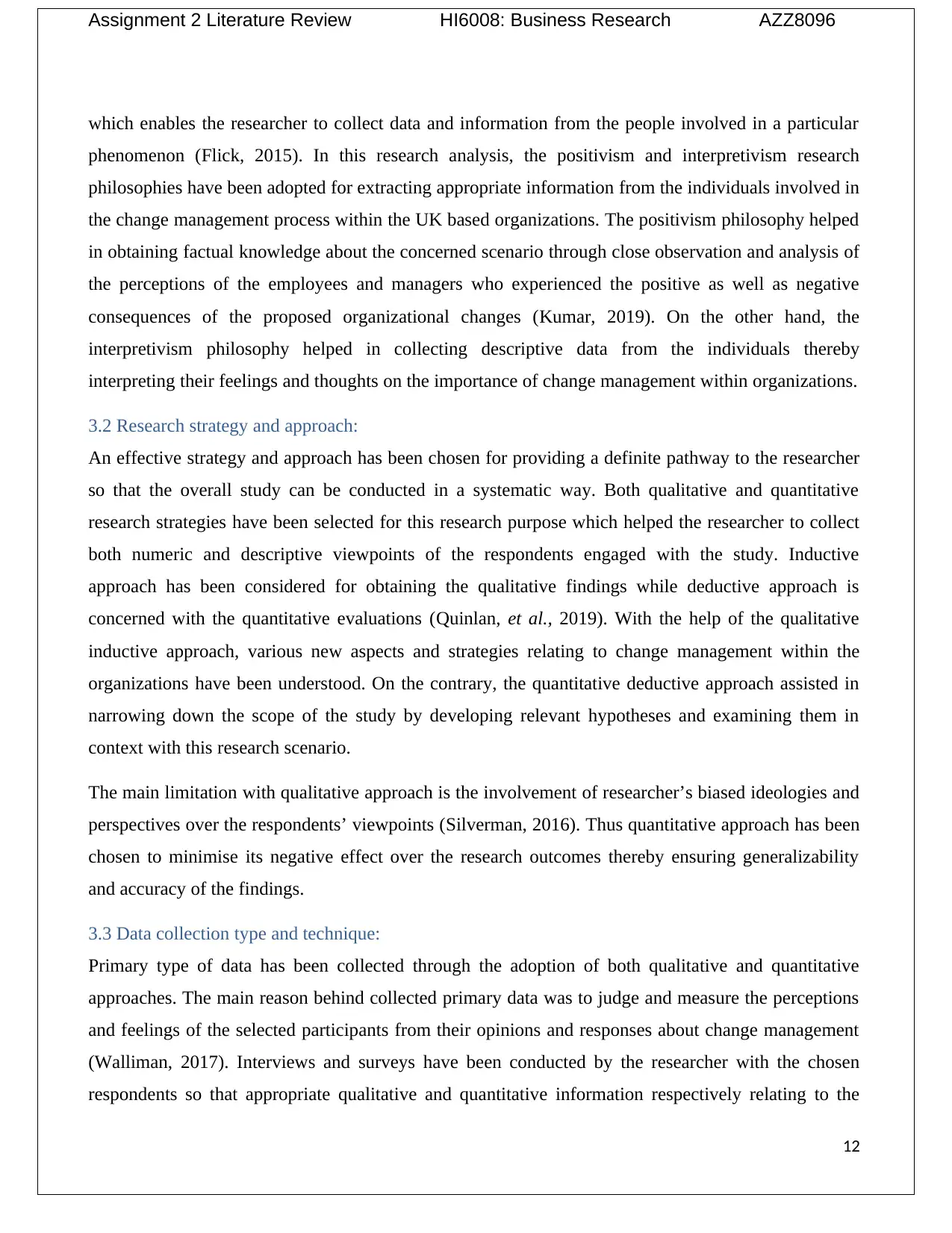
Assignment 2 Literature Review HI6008: Business Research AZZ8096
which enables the researcher to collect data and information from the people involved in a particular
phenomenon (Flick, 2015). In this research analysis, the positivism and interpretivism research
philosophies have been adopted for extracting appropriate information from the individuals involved in
the change management process within the UK based organizations. The positivism philosophy helped
in obtaining factual knowledge about the concerned scenario through close observation and analysis of
the perceptions of the employees and managers who experienced the positive as well as negative
consequences of the proposed organizational changes (Kumar, 2019). On the other hand, the
interpretivism philosophy helped in collecting descriptive data from the individuals thereby
interpreting their feelings and thoughts on the importance of change management within organizations.
3.2 Research strategy and approach:
An effective strategy and approach has been chosen for providing a definite pathway to the researcher
so that the overall study can be conducted in a systematic way. Both qualitative and quantitative
research strategies have been selected for this research purpose which helped the researcher to collect
both numeric and descriptive viewpoints of the respondents engaged with the study. Inductive
approach has been considered for obtaining the qualitative findings while deductive approach is
concerned with the quantitative evaluations (Quinlan, et al., 2019). With the help of the qualitative
inductive approach, various new aspects and strategies relating to change management within the
organizations have been understood. On the contrary, the quantitative deductive approach assisted in
narrowing down the scope of the study by developing relevant hypotheses and examining them in
context with this research scenario.
The main limitation with qualitative approach is the involvement of researcher’s biased ideologies and
perspectives over the respondents’ viewpoints (Silverman, 2016). Thus quantitative approach has been
chosen to minimise its negative effect over the research outcomes thereby ensuring generalizability
and accuracy of the findings.
3.3 Data collection type and technique:
Primary type of data has been collected through the adoption of both qualitative and quantitative
approaches. The main reason behind collected primary data was to judge and measure the perceptions
and feelings of the selected participants from their opinions and responses about change management
(Walliman, 2017). Interviews and surveys have been conducted by the researcher with the chosen
respondents so that appropriate qualitative and quantitative information respectively relating to the
12
which enables the researcher to collect data and information from the people involved in a particular
phenomenon (Flick, 2015). In this research analysis, the positivism and interpretivism research
philosophies have been adopted for extracting appropriate information from the individuals involved in
the change management process within the UK based organizations. The positivism philosophy helped
in obtaining factual knowledge about the concerned scenario through close observation and analysis of
the perceptions of the employees and managers who experienced the positive as well as negative
consequences of the proposed organizational changes (Kumar, 2019). On the other hand, the
interpretivism philosophy helped in collecting descriptive data from the individuals thereby
interpreting their feelings and thoughts on the importance of change management within organizations.
3.2 Research strategy and approach:
An effective strategy and approach has been chosen for providing a definite pathway to the researcher
so that the overall study can be conducted in a systematic way. Both qualitative and quantitative
research strategies have been selected for this research purpose which helped the researcher to collect
both numeric and descriptive viewpoints of the respondents engaged with the study. Inductive
approach has been considered for obtaining the qualitative findings while deductive approach is
concerned with the quantitative evaluations (Quinlan, et al., 2019). With the help of the qualitative
inductive approach, various new aspects and strategies relating to change management within the
organizations have been understood. On the contrary, the quantitative deductive approach assisted in
narrowing down the scope of the study by developing relevant hypotheses and examining them in
context with this research scenario.
The main limitation with qualitative approach is the involvement of researcher’s biased ideologies and
perspectives over the respondents’ viewpoints (Silverman, 2016). Thus quantitative approach has been
chosen to minimise its negative effect over the research outcomes thereby ensuring generalizability
and accuracy of the findings.
3.3 Data collection type and technique:
Primary type of data has been collected through the adoption of both qualitative and quantitative
approaches. The main reason behind collected primary data was to judge and measure the perceptions
and feelings of the selected participants from their opinions and responses about change management
(Walliman, 2017). Interviews and surveys have been conducted by the researcher with the chosen
respondents so that appropriate qualitative and quantitative information respectively relating to the
12
⊘ This is a preview!⊘
Do you want full access?
Subscribe today to unlock all pages.

Trusted by 1+ million students worldwide
1 out of 22
Related Documents
Your All-in-One AI-Powered Toolkit for Academic Success.
+13062052269
info@desklib.com
Available 24*7 on WhatsApp / Email
![[object Object]](/_next/static/media/star-bottom.7253800d.svg)
Unlock your academic potential
Copyright © 2020–2025 A2Z Services. All Rights Reserved. Developed and managed by ZUCOL.




